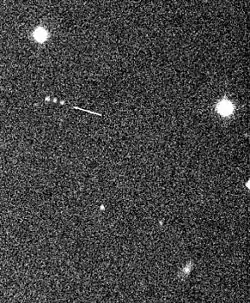Paaliaq
Paaliaq is a prograde irregular satellite of Saturn. It was discovered by J. J. Kavelaars, Brett J. Gladman, Jean-Marc Petit, Hans Scholl, Matthew J. Holman, Brian G. Marsden, Philip D. Nicholson and Joseph A. Burns in early October 2000,[7][8][9] and given the temporary designation S/2000 S 2.
 Time lapse of Paaliaq moving along its orbit that lead to its discovery | |
| Discovery[1] | |
|---|---|
| Discovered by | J. J. Kavelaars et al. |
| Discovery date | in 2000 |
| Designations | |
Designation | Saturn XX |
| Pronunciation | /ˈpɑːli.ɑːk/ |
| S/2000 S 2 | |
| Adjectives | Paaliapian, Paaliaqian[2] |
| Orbital characteristics[3] | |
| Epoch 2000 Feb. 26.00 | |
| 15.200 Gm | |
| Eccentricity | 0.3631 |
| 686.9 d (1.88 yr) | |
| Inclination | 45.083° |
| Satellite of | Saturn |
| Group | Inuit group |
| Physical characteristics | |
Mean diameter | 25+50% −30% km[4] |
| 18.79±0.09 h[4] | |
| Albedo | 0.04[5] assumed |
Spectral type | red B−V=0.86, R−V=0.40[6] D[6] |
It was named in August 2003 after a fictional shaman in the book The Curse of the Shaman, written by Michael Kusugak, who supplied Kavelaars with the names of giants from Inuit mythology that were used for other Saturnian moons.[10]
Paaliaq is thought to be about 22 kilometres in diameter, and orbits Saturn at an average distance of 15.2 million km in 687 days. It is a member of the Inuit group of irregular satellites. It also has a proximity with 9 other moons reaching up to ten miles from each.
It is light red in color, and in the infrared the Paaliapian (Paaliaqan)[2] spectrum is very similar to the Inuit-group satellites Kiviuq and Siarnaq, supporting the thesis of a possible common origin of the Inuit group in the break-up of a larger body.[6][11]

References
- Discovery Circumstances (JPL)
- The genitive form of Paaliaq is Paaliap. Thus the adjectival form could be absolutive Paaliaqian or genitive Paaliapian, parallel to nominative Venusian and genitive Venerian for Venus. See Inuktitut morphology
- Mean orbital parameters from NASA JPL
- Denk, T.; Mottola, S. (2019). Cassini Observations of Saturn's Irregular Moons (PDF). 50th Lunar and Planetary Science Conference. Lunar and Planetary Institute.
- Scott Sheppard pages
- Grav, T.; and Bauer, J.; A deeper look at the colors of Saturnian irregular satellites
- https://ui.adsabs.harvard.edu/link_gateway/2004Icar..169..474K/doi:10.1016/j.icarus.2004.01.009
- IAUC 7512: S/2000 S 1 and S/2000 S 2 25 October 2000 (discovery)
- MPEC 2000-Y15: S/2000 S 1, S/2000 S 2, S/2000 S 7, S/2000 S 8, S/2000 S 9 19 December 2000 (discovery and ephemeris)
- Petten, Cheryl. "Naming Saturn's moons". Ammsa.com. Aboriginal Multi-Media Society.
The fourth name, Paaliaq, is a character Kusugak created in his latest book, Marble Island-The Curse of the Shaman, which Kusugak is currently trying to get published. The characters Kiviuq and Siarnaq are also found in the book.
- Gladman, B. J.; Nicholson, P. D.; Burns, J. A.; Kavelaars, J. J.; Marsden, B. G.; Holman, M. J.; Grav, T.; Hergenrother, C. W.; Petit, J.-M.; Jacobson, R. A.; and Gray, W. J.; Discovery of 12 satellites of Saturn exhibiting orbital clustering, Nature, 412 (July 12, 2001), pp. 163–166
- Ephemeris IAU-MPC NSES
.jpg.webp)